Ultrasound needle guides for Philips transducers
Victor Duran2024-12-03T17:57:41-05:00Reusable and Disposable Ultrasound Needle Guides for Philips
We offer needle guides for most Philips ultrasound transducers. The easiest way to find your specific needle guide is to identify your transducer’s model. To see your guide up close type the information into the search bar above or you can look through the list below (in alphabetical order).
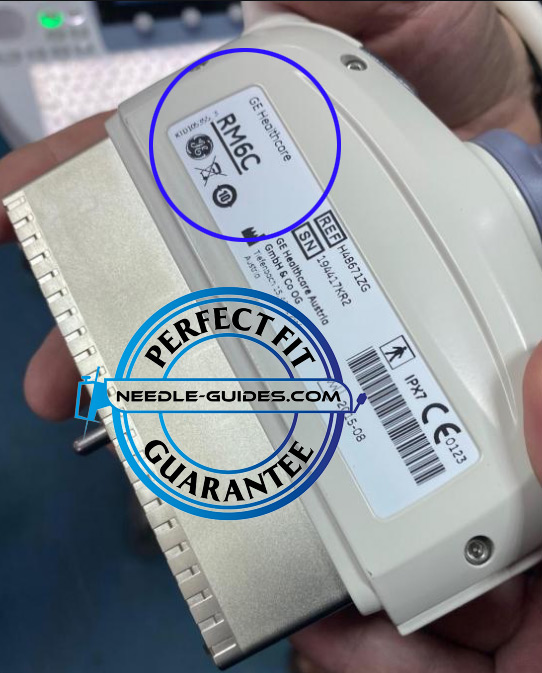
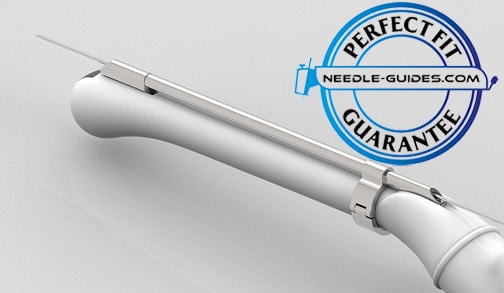
Reusable Transvaginal & Transrectal Philips Ultrasound Needle Guides
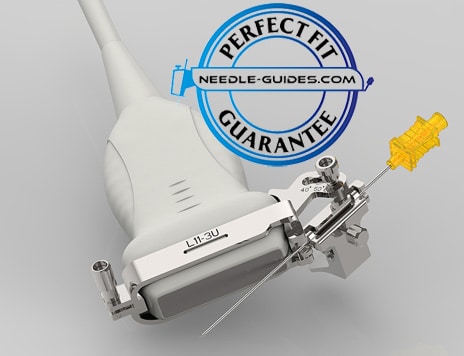
Reusable Linear Philips Ultrasound Needle Guides
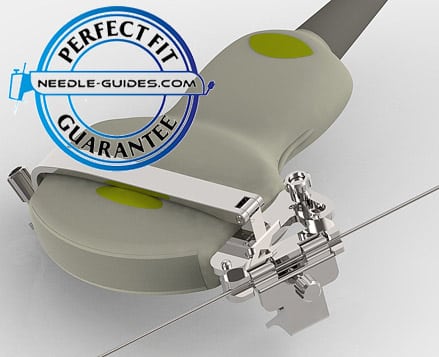
Reusable Convex Philips Ultrasound Needle Guides
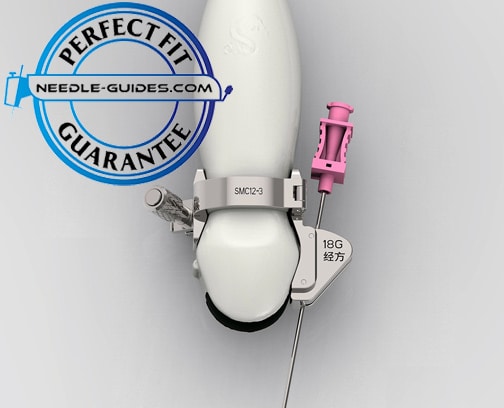
Reusable Micro convex Philips Ultrasound Needle Guides
Reusable Volumetric Philips Ultrasound Needle Guides
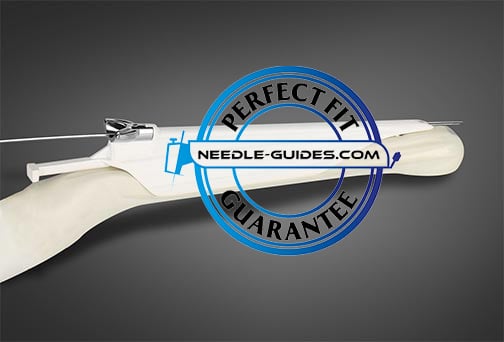
Disposable Philips Ultrasound Needle Guides

Can't find your Philips ultrasound needle guide? We can help!
Ultrasound Needle Guide Quotation request
"*" indicates required fields



ULTRASOUND NEEDLE GUIDES FOR ENDOCAVITY PHILIPS PROBES
A needle guide mounted on your Philips endocavity transducer is commonly used for ultrasound-guided procedures that involve accessing organs or structures through body cavities. Specifically, the endocavity transducer is specifically designed for imaging within body cavities, such as the rectum, vagina, or esophagus, and provides high-resolution images in close proximity to the target area. Correspondingly, a needle guide attached to an endocavity transducer, facilitates accurate needle placement and enhances procedural guidance for various medical purposes, including:
Transrectal prostate procedures: A needle guide used with your your Philips endocavity transducer assists in accurately targeting the prostate gland in procedures such as prostate biopsies or brachytherapy. In this situation, it helps guide the biopsy needle or the radioactive seeds to the desired locations within the prostate, ensuring precise sampling or treatment delivery.
Transvaginal interventions: A needle guide used in conjunction with your Philips endocavity transducer can be used for interventions such as cyst aspirations or uterine fibroid ablations in gynecological procedures. For this purpose, the needle guide allows for precise needle placement in therapeutic interventions targeting cysts or fibroids within the vagina or uterus.
Endorectal interventions: A needle guide equipped with your Philips endocavity transducer can be utilized for interventions such as biopsies or abscess drainages in procedures involving the rectum or anal canal. Specifically, it helps guide the needle to the target area within the rectum, facilitating accurate sampling or drainage procedures.
Endoscopic ultrasound-guided interventions: A needle guide attached to your Philips endocavity transducer can be used for precise fine-needle aspirations or injections in endoscopic procedures. In this case, it provides real-time visualization and precise needle guidance for sampling or therapeutic interventions within the gastrointestinal tract, such as the esophagus, stomach, or rectum.
In summary, a needle guide fitted on your Philips endocavity transducer enables accurate and real-time visualization during procedures within body cavities. It improves the safety, accuracy, and success rates of needle placements, reducing the risk of complications and improving patient outcomes.

ULTRASOUND NEEDLE GUIDES FOR CONVEX PHILIPS PROBES
A needle guide mounted on your Philips convex transducer is typically used for ultrasound-guided procedures that involve the insertion of a needle or catheter into the body. Specifically, the convex transducer refers to the type of ultrasound probe that has a curved or convex shape, allowing for a wider field of view and deeper penetration into the body.
Therefore, the needle guide serves as a tool to assist in accurate and precise needle placement during procedures such as:
Biopsy: A needle guide used with your Philips convex transducer can be used during ultrasound-guided biopsies, where a tissue sample is obtained for diagnostic purposes. For this purpose, the guide helps in aligning the needle with the target tissue, ensuring that the biopsy is performed at the desired location.
Aspiration and drainage: A needle guide attached to your Philips convex transducer can be used to guide the needle precisely to the desired location in procedures that involve draining fluid collections or aspirating fluid from a specific area, while minimizing the risk of damaging surrounding structures.
Nerve blocks and regional anesthesia: A needle guide coupled with your Philips convex transducer can assist in accurate needle placement near nerves or specific anatomical landmarks during nerve blocks or regional anesthesia procedures. In particular, this helps in delivering local anesthetic agents precisely, ensuring effective pain management or surgical anesthesia.
Vascular access: A needle guide equipped with your Philips convex transducer can aid in identifying and targeting the desired blood vessel accurately when inserting a central venous catheter or performing peripheral vascular access. In this case, facilitating in successful cannulation and reducing the risk of complications.
In summary, a needle guide fitted with your Philips convex transducer provides real-time visualization and guidance, allowing medical professionals to perform procedures with increased precision, reduced risk, and improved patient outcomes.
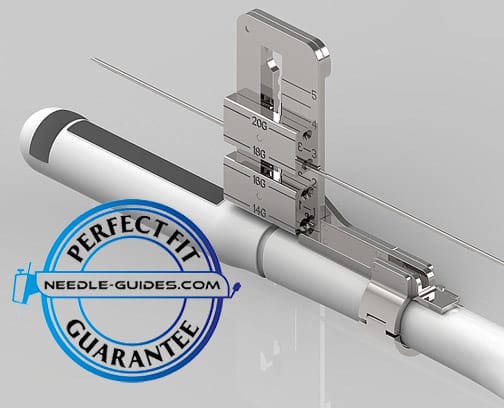
ULTRASOUND NEEDLE GUIDES FOR TRANSRECTALPHILIPS PROBES
A needle guide mounted on your Philips transrectal transducer is commonly used for various medical purposes that involve procedures within the rectum or adjacent structures. Some of the specific medical purposes for which a needle guide on a transrectal transducer can be utilized include:
Prostate biopsy: The needle guide attached to your Philips transrectal transducer helps in accurately targeting different regions of the prostate gland during biopsy, ensuring appropriate sampling and increasing the diagnostic yield. For example, Transrectal ultrasound (TRUS)-guided prostate biopsy is a common procedure for diagnosing prostate cancer.
Focal therapy: The needle guide coupled with your Philips transrectal transducer assists in guiding treatment probes, such as cryoprobes or high-intensity focused ultrasound (HIFU) applicators, to the specific areas within the prostate that require therapy. As a result, focal therapy is a minimally invasive treatment option for localized prostate cancer.
Transrectal drainage and aspiration: A needle guide used with your Philips transrectal transducer can be used for accurate needle placement during drainage or aspiration procedures in cases of abscesses, cysts, or fluid collections within the rectum or adjacent structures. Therefore, it enables the visualization and guidance necessary for effective fluid removal or sampling.
Transrectal interventions: The needle guide fitted your Philips transrectal transducer can also aid in other transrectal interventions, such as the placement of fiducial markers for radiation therapy, injection of therapeutic agents, or transrectal aspiration of masses or lesions for diagnostic purposes.
In summary, a needle guide fitted to your Philips transrectal transducer enhances the accuracy and safety of needle placement, reduces the risk of complications, and improves the overall success of the intervention. The transrectal approach allows for close proximity to the target area, providing real-time imaging and guidance during these procedures.
